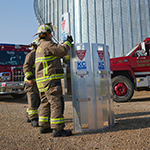Entry permits: Grain bins vs. confined spaces
A side-by-side comparison of the requirements for grain bins and confined spaces.
Grain bins, silos, pits, tanks, hoppers and vaults can potentially be hazardous. The atmosphere in these spaces may be oxygen deficient or contain a hazardous level of a toxic contaminant — such as hydrogen sulfide or carbon monoxide — which could result in a fatality. That’s why the Occupational Safety and Health Administration (OSHA) requires employers to follow certain precautions, such as insuring the completion of an entry permit prior to entry.
Grain bins
OSHA’s Grain Handling Facilities Standard (29 CFR 1910.272) requires that prior to entering a grain bin, the employer must either issue an entry permit or be present during the entire entry. Even though a permit may not be required prior to grain bin entry (as defined in the Grain Handling Facilities Standard), the supervisor/employer must ensure that certain requirements are completed before and during entry. This standard applies to grain-storage structures such as bins, silos and tanks, and applies to the following:
- Feed mills
- Flour mills
- Rice mills
- Dust pelletizing plants
- Dry corn mills
- Soybean flaking
- Grain elevators
- Dry grinding of soy cake
Confined spaces
OSHA’s Permit Required Confined Spaces Standard (29 CFR 1910.146) requires that a permit be completed prior to an employee entering an identified permit-required confined space. This standard (not the OSHA Grain Handling Facilities Standard) applies to the following structures:
- Pits (boot, dump, etc.)
- Tanks (fuel, mineral oil, etc.)
- Vessels
- Hoppers
- Vaults
If any of the above structures is determined to contain a potentially hazardous atmosphere, a confined space entry permit must be completed prior to entry, regardless if it’s used to store or handle grain.
Side-by-side comparison
The table below shows a side-by-side comparison of the requirements for the OSHA Grain Handling Facilities entry permit verses the OSHA Permit Required Confined Spaces entry permit. Please note the similarities in the requirements for these two permits. The italicized items are specific for each permit.
| Grain Bin Entry Permit Requirements | Confined Space Entry Permit Requirements |
|---|---|
|
|
Recommendation
Nationwide recommends that a permit be used for any entry into any potentially hazardous space, whether it falls under the Grain Handling Facilities Standard or the Permit Required Confined Spaces Standard. A permit helps ensure that proper precautions are taken prior to entry.
Separate permits for entering a grain bin structure and for entering a confined space can be developed, or you may find it beneficial to develop a common permit that includes requirements for both types. Either way, we have grain bin and confined space permit examples to help you develop your own permits.

 >
>

 >
>
 >
>